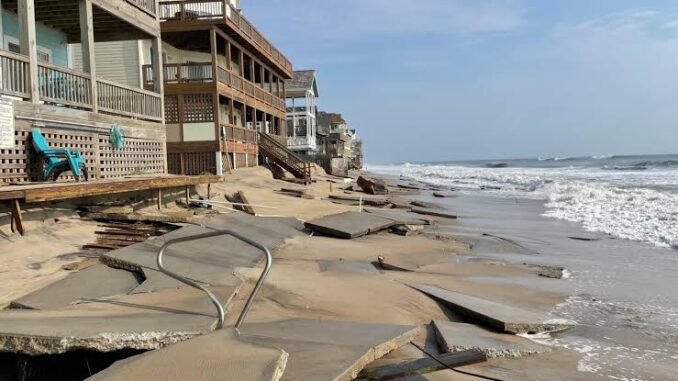
DESTRUCTION HITS PARADISE: HURRICANE DEVASTATES OUTER BANKS, LEAVING THOUSANDS HOMELESS AND HEARTBROKEN
In a shocking and unprecedented turn of events, the picturesque Outer Banks, a beloved tourist destination off the coast of North Carolina, has been ravaged by one of the most powerful hurricanes in recent memory. The storm, which struck late Sunday night, left a trail of destruction that has left thousands homeless and entire communities in a state of despair.
The hurricane, which has been named Hurricane Helena, made landfall with winds exceeding 150 mph, causing widespread devastation along the islands. In a matter of hours, homes were obliterated, businesses were flooded, and iconic landmarks were destroyed. What was once a peaceful coastal paradise has now become a scene of chaos and tragedy.
Rescue operations are underway, with local and national authorities scrambling to reach affected areas. However, access to the islands remains limited due to collapsed bridges and rising floodwaters. The storm has knocked out power to the majority of the region, leaving thousands without electricity and cutting off communication lines. Emergency responders have reported that they are working around the clock to save as many lives as possible, but the scale of the damage is overwhelming.
Thousands of residents have been forced to seek shelter in makeshift facilities and emergency shelters set up in nearby cities. Many of the displaced have lost everything, their homes reduced to rubble and their livelihoods shattered. Among the displaced, there is a deep sense of heartbreak and loss. “It feels like a nightmare,” said Linda Matthews, a long-time resident of Nags Head, her voice trembling with emotion. “This was our home, our paradise, and now it’s all gone.”
The economic impact on the Outer Banks, a region heavily dependent on tourism, is expected to be catastrophic. Local businesses, including restaurants, hotels, and shops, have been flooded or destroyed. Many workers in the tourism industry are now facing an uncertain future as the region begins its long road to recovery.
The hurricane has also caused severe environmental damage. The region’s fragile coastal ecosystem has been disrupted, with rising waters inundating marshlands and wildlife habitats. Residents are concerned about the long-term impact on local flora and fauna, especially as the area is home to rare species and protected lands. “The land, the animals—it’s all at risk,” said environmentalist Charles Dunn. “We’re facing a catastrophe that extends beyond just human lives. This storm is going to change everything.”
Despite the enormity of the devastation, there have been moments of resilience. Communities have come together to provide aid and support for the displaced. Neighbors have opened their doors to strangers, and volunteers from across the state have begun pouring in to help with the cleanup efforts. “We’re all in this together,” said Sarah Thompson, a volunteer from Raleigh. “It’s going to take time, but we will rebuild.”
Officials are urging those in the impacted areas to stay in shelters until it is safe to return. Governor Elizabeth Thomas has declared a state of emergency for the Outer Banks and neighboring areas, requesting federal assistance to speed up recovery efforts. “The recovery process will be long and difficult, but we are committed to bringing our communities back,” the governor said in a press conference.
As the Outer Banks begins to process the devastation, the focus will be on rebuilding not just homes, but the spirit of the people who call this paradise home. The road ahead is uncertain, but one thing remains clear—the Outer Banks will rise again, though the scars of this tragedy will remain for years to come.
Leave a Reply